Sustainable Downtown Development for the Tsunami-Prepared Urban Revitalization of Regional Coastal Cities
Abstract
1. Introduction
2. Materials and Methods
2.1. Overview of Kushiro City
2.2. Risks of Tsunamis in the Downtown Area
2.3. The Deae-ru Saiwai Estate: Public Housing with Tsunami Evacuation Facilities
2.4. Evaluation Methods for the Saiwai Estate (Table 1)
3. Results
3.1. [Survey A] The Questionnaire Survey for Residents of the Estate
3.2. [Survey A-2] Change in Commuting Distance and Distance to Public Facilities after Moving
3.3. [Survey B] Improvement of the Usability of the Estate as an Evacuation Facility
3.4. [Survey C] Reduction in Evacuation Distance Around the Saiwai Estate
3.5. [Survey D-1] Questionnaire Survey for Residents of the Estate
3.6. [Survey D-2] Questionnaire Survey for Residents Surrounding the Estate
4. Discussion
5. Conclusions
5.1. The Effects of Relocating Public Housing with a Public Facility to the Downtown Area [Survey A-1] [Survey A-2] [Survey B]
- Building public housing in the downtown area induces a population shift from suburban areas to the downtown area.
- On the other hand, residents living in downtown areas near the coast face a higher tsunami risk.
- By placing public housing in the downtown area, the satisfaction of the residents and the convenience of the surrounding environment are improved compared to before moving.
- Building public housing in the downtown area could reduce the distance to public facilities compared to before moving.
- Installing a tsunami evacuation facility in a public facility that is open to the neighborhood can improve the function of the evacuation facility at the time of disaster.
5.2. The Effects of Installing an Evacuation Facility in the Estate [Survey C] [Survey D-1] [Survey D-2]
- Constructing public housing with tsunami evacuation facilities in the downtown area of a coastal city can reduce the shortest evacuation distances of the surrounding residents.
- Installing a tsunami evacuation facility in on the upper floors of a high-rise public housing building can improve the reassurance of the residents in and around the public housing area with regards to the threat of tsunamis.
5.3. The Effects of Dealing with the Promotion of Downtown Living and the Improvement of Tsunami Evacuation Performance in Parallel for Downtown Revitalization
Author Contributions
Funding
Acknowledgments
Conflicts of Interest
References
- Japan’s Future Population. Available online: http://www.ipss.go.jp/pp-zenkoku/j/zenkoku2017/pp29_gaiyou.pdf (accessed on 6 November 2018).
- Sakamoto, K.; Iida, A.; Yokohari, M. Spatial patterns of population turnover in a Japanese Regional City for urban regeneration against population decline: Is Compact City policy effective? Cities 2018, 81, 230–241. [Google Scholar] [CrossRef]
- Population Vision in Hokkaido. Available online: http://www.pref.hokkaido.lg.jp/ss/csr/ksk/jinkou/kyogikai/3_shiryo3.pdf (accessed on 6 November 2018).
- Gumma, M.K.; Mohammad, I.; Nedumaran, S.; Whitbread, A.; Lagerkvist, C.J. Urban Sprawl and Adverse Impacts on Agricultural Land: A Case Study on Hyderabad, India. Remote Sens. 2017, 9, 1136. [Google Scholar] [CrossRef]
- Li, X.; Yang, L.; Ren, Y.; Li, H.; Wang, Z. Impacts of Urban Sprawl on Soil Resources in the Changchun–Jilin Economic Zone, China, 2000–2015. Int. J. Environ. Res. Public Health 2018, 15, 1186. [Google Scholar] [CrossRef] [PubMed]
- Ala-Mantila, S.; Heinonen, J.; Junnila, S. Greenhouse Gas Implications of Urban Sprawl in the Helsinki Metropolitan Area. Sustainability 2013, 5, 4461–4478. [Google Scholar] [CrossRef]
- Li, K.-Q.; Lu, R.; Chu, R.-W.; Ma, D.-D.; Zhu, L.-Q. Trends and Driving Forces of Carbon Emissions from Energy Consumption: A Case Study of Nanjing, China. Sustainability 2018, 10, 4348. [Google Scholar] [CrossRef]
- Bo, C.; Xu, H.; Liu, Y. Examination of the Relationships between Urban Form and Urban Public Services Expenditure in China. Adm. Sci. 2017, 7, 39. [Google Scholar]
- Zolnik, E.J. The costs of sprawl for private-vehicle commuters. J. Transp. Geogr. 2012, 20, 23–30. [Google Scholar] [CrossRef]
- Setoguchi, T.; Nagao, M.; Okabe, Y.; Oinuma, T.; Matsumura, H. The development of future city images based on the citizen’s demands for intensive compact cities. The planning approaches for downsizing of city area on Yubari city master plan. Trans. Archit. Inst. Jpn. J. Archit. Plan. Environ. Eng. 2014, 79, 949–958. [Google Scholar]
- Wang, H.J.; Lee, H.Y. How government-funded projects have revitalized historic streetscapes—Two cases in Taiwan. Cities 2008, 25, 197–206. [Google Scholar] [CrossRef]
- Balsas, C.J.L.; Robertson, K.A. Can small-city downtowns remain viable?: City center revitalization in Portugal. JAPA 1999, 65, 270–283. [Google Scholar]
- Spader, J.; Schuetz, J.; Cortes, A. Fewer vacants, fewer crimes? Impacts of neighborhood revitalization policies on crime. Reg. Sci. Urban Econ. 2016, 60, 73–84. [Google Scholar] [CrossRef]
- Tamura, S.; Iwamoto, S.; Tanaka, T. The impact of spatial population distribution patterns on CO2 emissions and infrastructure costs in a small Japanese town. SCS 2018, 40, 513–523. [Google Scholar]
- Takayuki, K.; Higuchi, S.; Nakade, B.; Matsukawa, T. Study on Relationship between Fixed Property Tax Revenue and Building Activity in Local Cities—A Case Study of Three Non-Area Divided Cities, Ueda City, Ise City and Okinawa City. J. City Plan. Inst. Jpn. 2015, 50, 879–885. [Google Scholar]
- Country Grand Design 2050. Available online: http://www.mlit.go.jp/common/001047113.pdf (accessed on 7 November 2018).
- Doratli, N. Revitalizing historic urban quarters: A model for determining the most relevant strategic approach. Eur. Plan. Stud. 2005, 13, 749–772. [Google Scholar] [CrossRef]
- Park, C. Lessons of downtown revitalization plans in Korea. Urban Policy Res. 2004, 22, 447–463. [Google Scholar] [CrossRef]
- Osman, K.A.; Farahat, B.I. The conservation of the waterfront of Saida: A model for tourism and culture-led revitalization in valuable areas. HBRC J. 2018, 14, 321–333. [Google Scholar] [CrossRef]
- Vukonic, B.; Tkalack, D. Tourism and Urban Revitalization: A Case Study of Pore& Yugoslavia. Ann. Tour. Res. 1984, 11, 591–605. [Google Scholar]
- Miyauchi, T.; Setoguchi, T.; Kitahara, K.; Nakata, H.; Ito, T. Quantitative evaluations of the downtown habitation programs with public housing redevelopments toward the consolidated compact cities. Trans. Archit. Inst. Jpn. J. Archit. Plan. Environ. Eng. 2018, 83, 1025–1035. [Google Scholar] [CrossRef]
- Galster, C.G.; Hesser, W.G. Residential satisfaction: Compositional and contextual correlates. Environ. Behav. 1981, 13, 735–758. [Google Scholar] [CrossRef]
- Riazi, M.; Emami, A. Residential satisfaction in affordable housing: A mixed method study. Cities 2018, 82, 1–9. [Google Scholar] [CrossRef]
- Mu, S. Community Building in Social-Mix Public Housing: Participatory planning of Ankang redevelopment plan. Behav. Soc. Sci. Libr. 2016, 222, 755–762. [Google Scholar] [CrossRef]
- Morris, A.; Jamieson, M.; Patulny, R. Is social mixing of tenures a solution for public housing estates. Evid. Base 2012, 1, 1–21. [Google Scholar]
- Tam, V.W.Y.; Fung, I.W.H.; Tsang, Y.T.; Chan, L. Development of a Universal Design-Based Guide for Handrails: An Empirical Study for Hong Kong Elderly. Sustainability 2018, 10, 4233. [Google Scholar] [CrossRef]
- Economic and Fiscal Effects of Consolidation and Declaration of Public Facilities etc. Available online: https://www5.cao.go.jp/keizai3/2016/08seisakukadai09-0.pdf (accessed on 10 November 2018).
- Child-rearing Support Housing Promotion Policy in Hokkaido. Available online: http://www.pref.hokkaido.lg.jp/kn/jtk/grp/100915-3kosodatepamph.pdf (accessed on 10 November 2018).
- Tomita, T.; Imamura, F.; Arakawa, T.; Yasuda, T.; Kawata, Y. Damage caused by the 2004 Indian Ocean Tsunami on the southwestern coast of Sri Lanka. Coast. Eng. J. 2006, 48, 99–116. [Google Scholar] [CrossRef]
- Mori, N.; Takahashi, T.; Yasuda, T.; Yanagisawa, H. Survey of 2011 Tohoku earthquake tsunami inundation and run-up. Geophys. Res. Lett. 2011, 38. [Google Scholar] [CrossRef]
- Goto, K.; Ikehara, K.; Goff, J.; Chague-Goff, C.; Jaffe, B. The 2011 Tohoku-oki tsunami-Three years on. Mar. Geol. 2014, 358, 2–11. [Google Scholar] [CrossRef]
- Sun, Y.; Yamori, K. Risk Management and Technology: Case Studies of Tsunami Evacuation Drills in Japan. Sustainability 2018, 10, 2982. [Google Scholar] [CrossRef]
- Lee, S.W.; Song, D.W.; Ducruet, C. A tale of Asia’s world ports: The spatial evolution in global hub port cities. Geoforum 2008, 39, 372–385. [Google Scholar] [CrossRef]
- Ishii, A.; Suzuki, H.; Setoguchi, T. Residential land supply methods to develop a housing reconstruction scenario in a large tsunami-devastated area: Time series analysis of residential land supply based on building GIS database after the Great East Japan Earthquake in Rikuzentakata city, Iwate. Trans. Archit. Inst. Jpn. J. Archit. Plan. Environ. Eng. 2018, 83, 1273–1283. [Google Scholar]
- Sina, D.; Chang-Richards, A.Y.; Wilkinson, S.; Potangaroa, R. What does the future hold for relocated communities post-disaster? Factors affecting livelihood resilience. Int. J. Dis. Risk Reduct. 2018. [Google Scholar] [CrossRef]
- Dall’Osso, F.; Dominey-Howes, D. Public assessment of the usefulness of “draft” tsunami evacuation maps from Sydney, Australia–implications for the establishment of formal evacuation plans. Nat. Hazards Earth Syst. 2010, 10, 1739–1750. [Google Scholar] [CrossRef]
- Wegscheider, S.; Post, J.; Zosseder, K.; Muck, M.; Strunz, G.; Riedlinger, T.; Muhari, A.; Anwar, Z.H. Generating tsunami risk knowledge at community level as a base for planning and implementation of risk reduction strategies. Nat. Hazards Earth Syst. 2011, 11, 249–258. [Google Scholar] [CrossRef]
- Chock, G.; Butler, R. Evacuation planning considerations of the city of Honolulu for a Great Aleutian Tsunami. In Proceedings of the Tenth U.S. National Conference on Earthquake Engineerin, Frontiers of Earthquake Engineerin, Anchorage, AK, USA, 21–25 July 2014. [Google Scholar]
- Goseberg, N.; Schlurmann, T. Non-stationary flow around buildings during run-up of tsunami waves on a plain beach. Coast. Eng. 2014, 34. [Google Scholar] [CrossRef]
- Scheer, J.S.; Varela, V.; Eftychidis, G. A generic framework for tsunami evacuation planning. Phys. Chem. Earth 2012, 49, 79–91. [Google Scholar] [CrossRef]
- Suppasri, A.; Shuto, N.; Imamura, F.; Koshimura, S.; Mas, E.; Yalciner, C.A. Lessons learned from the 2011 great east japan tsunami: Performance of tsunami countermeasures, coastal buildings, and tsunami evacuation in Japan. Pure Appl. Geophys. 2013, 170, 993–1018. [Google Scholar] [CrossRef]
- Ogawa, M.; Tsuboi, S.; Kuroyanagi, A. Research on designation and management of tsunami evacuation building. Pap. Environ. Inf. Sci. 2012, 26, 289–294. [Google Scholar]
- Specified Number of Tsunami Evacuation Building by Prefecture. Available online: http://www.mlit.go.jp/common/000186681.pdf (accessed on 12 November 2018).
- Mohit, A.M.; Ibrahim, M.; Rashid, R.Y. Assessment of residential satisfaction in newly designed public low-cost housing in Kuala Lumpur, Malaysia. Habitat Int. 2010, 34, 18–27. [Google Scholar] [CrossRef]
- Tao, Z.; Cheng, Y.; Dai, T. Measuring spatial accessibility to residential care facilities in Beijing. Popul. Health Geogr. 2014, 33, 616–624. [Google Scholar]
- Tsunami Evacuation Plan in Kushiro City. Available online: https://www.city.kushiro.lg.jp/common/000126473.pdf (accessed on 13 November 2018).
- Miyamori, Y.; Uchiumi, K.; Shimizu, T.; Yamasaki, S.; Otsuka, H. A basic study of tsunami evacuation to shelter buildings and civil structures in Kushiro City. Editorial Comm. J. Jpn. Soc. Civ. Eng. (Struct./Earthq. Eng.) 2013, 69, 919–931. [Google Scholar]
- Saito, T.; Muramoto, H.; Shimizu, T.; Miyamori, Y. A study of tsunami evacuation with consideration for damage to tall buildings in Kushiro City. J. Soc. Saf. Sci. 2014, 24, 151–159. [Google Scholar]
- Kawakami, T.; Asano, M. A study on the sense of security that a disaster measure gives to citizens. J. City Plan. Inst. Jpn. 2001, 36, 409–414. [Google Scholar]
- Dewita, Y.; Barbara, T.H.Y.; Burke, M. The effect of transport cost on housing affordability: Experiences from the T Bandung Metropolitan Area, Indonesia. Land Use Policy 2018, 79, 507–519. [Google Scholar] [CrossRef]
- Nishimura, H.; Kurimata, K.; Iwasaki, Y.; Yamaguchi, Y. A study on the recognition and selection factors of the evacuation destination and evacuation route against the tsunami disaster. Proc. City Plan. Inst. Jpn. Kansai Branch 2012, 10, 73–76. [Google Scholar]
- Zhigang, L.; Fulong, W. Residential satisfaction in China’s informal settlements: A case study of Beijing, Shanghai, and Guangzhou. Urban Geogr. 2013, 34, 923–949. [Google Scholar]
- Chaskin, J.R.; Joseph, L.M. Social interaction in mixed-income developments: Relational expectations and emerging reality. Urban Aff. A 2011, 35, 423–431. [Google Scholar] [CrossRef]
- Parkes, A.; Kearns, A.; Atkinson, R. What makes people dissatisfied with their neighborhoods? Urban Stud. 2002, 39, 2413–2438. [Google Scholar] [CrossRef]
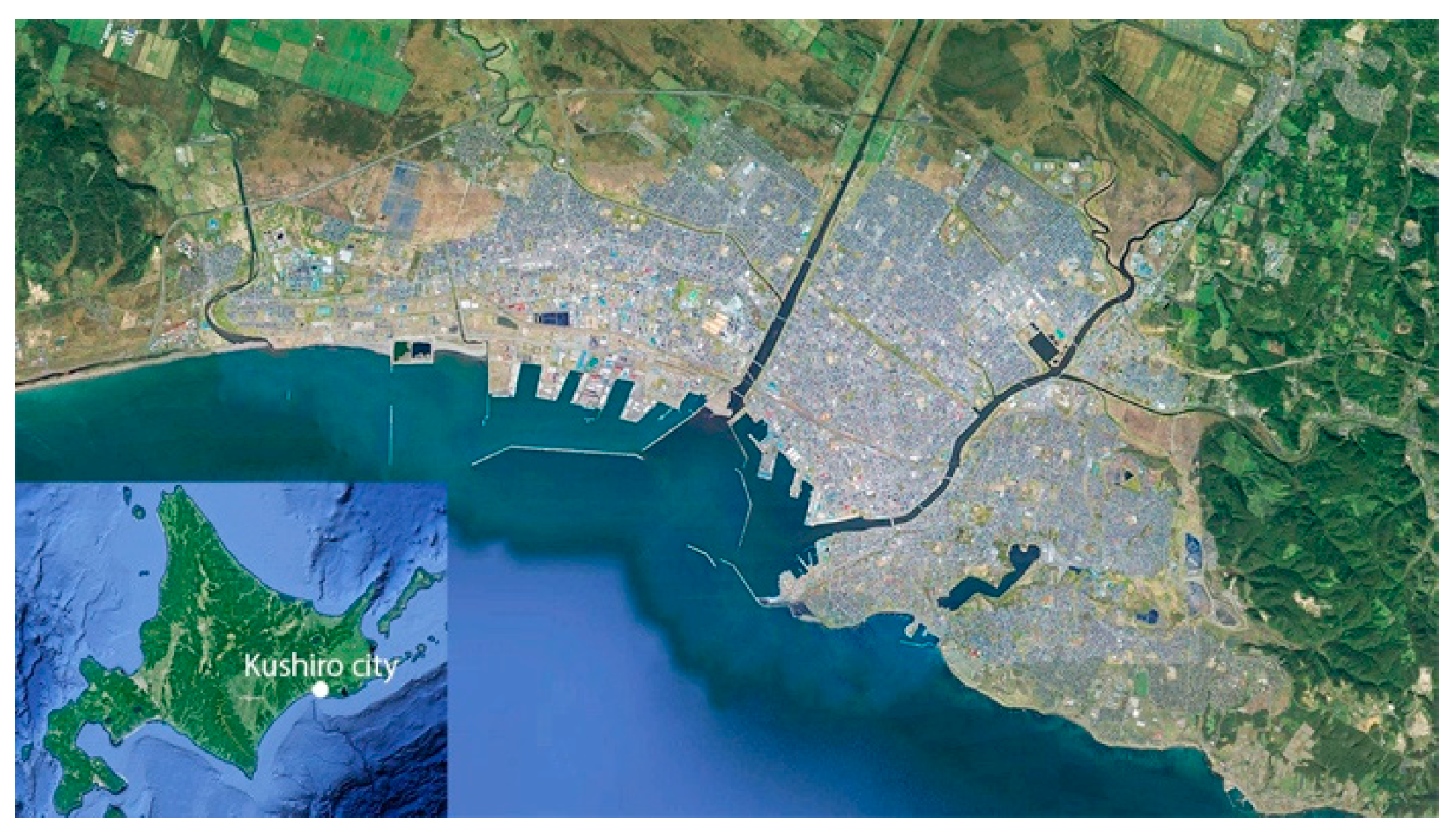
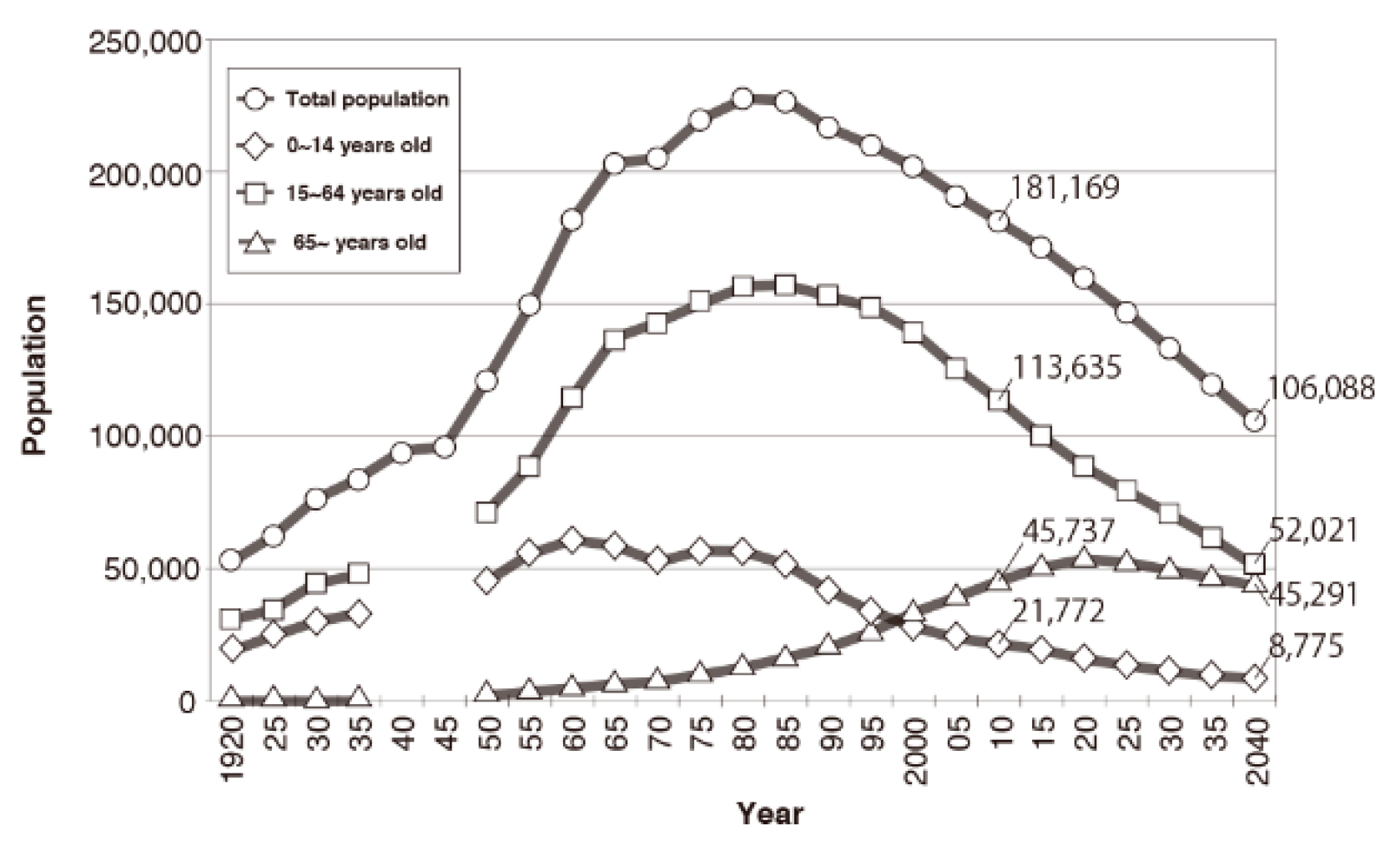

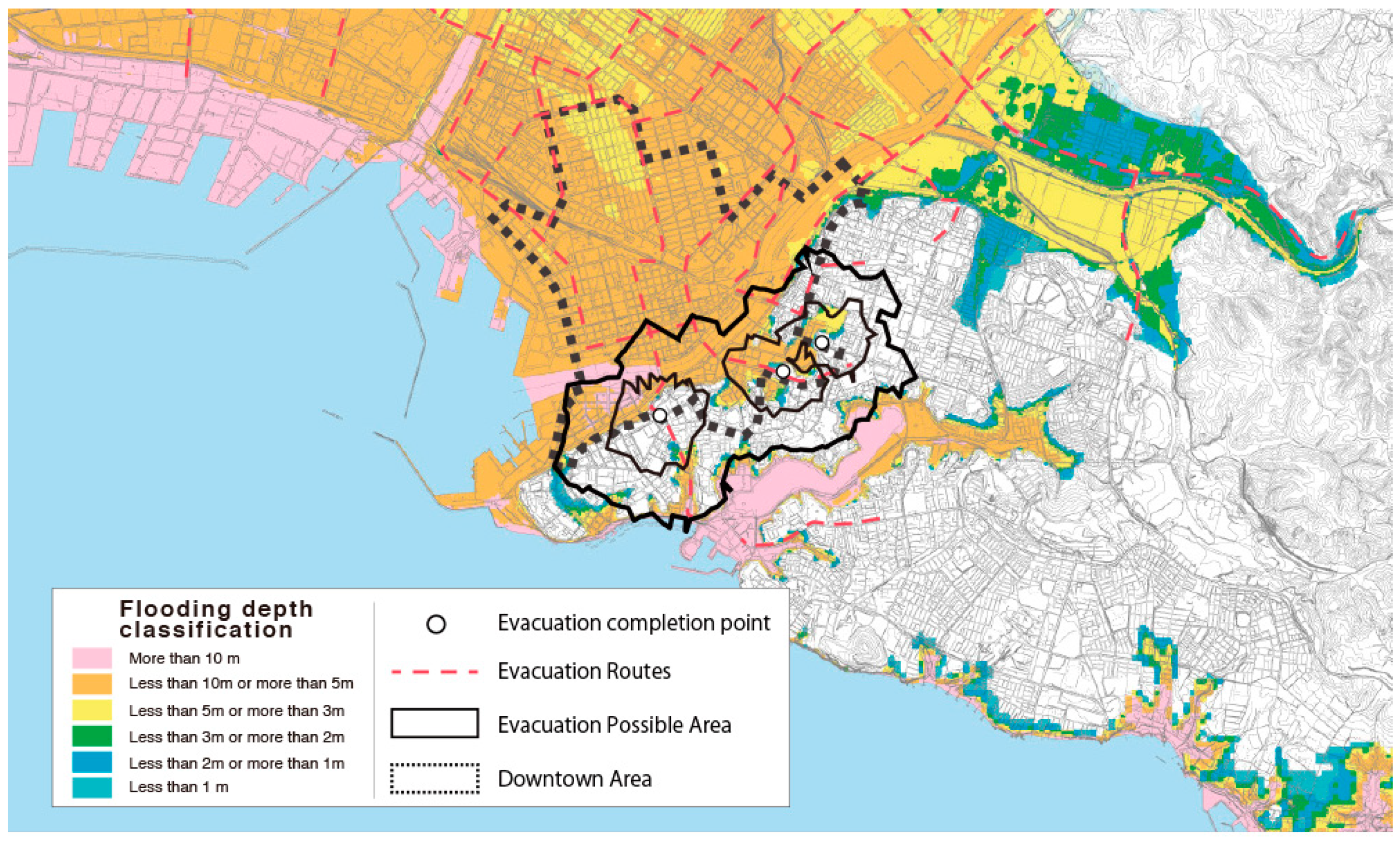
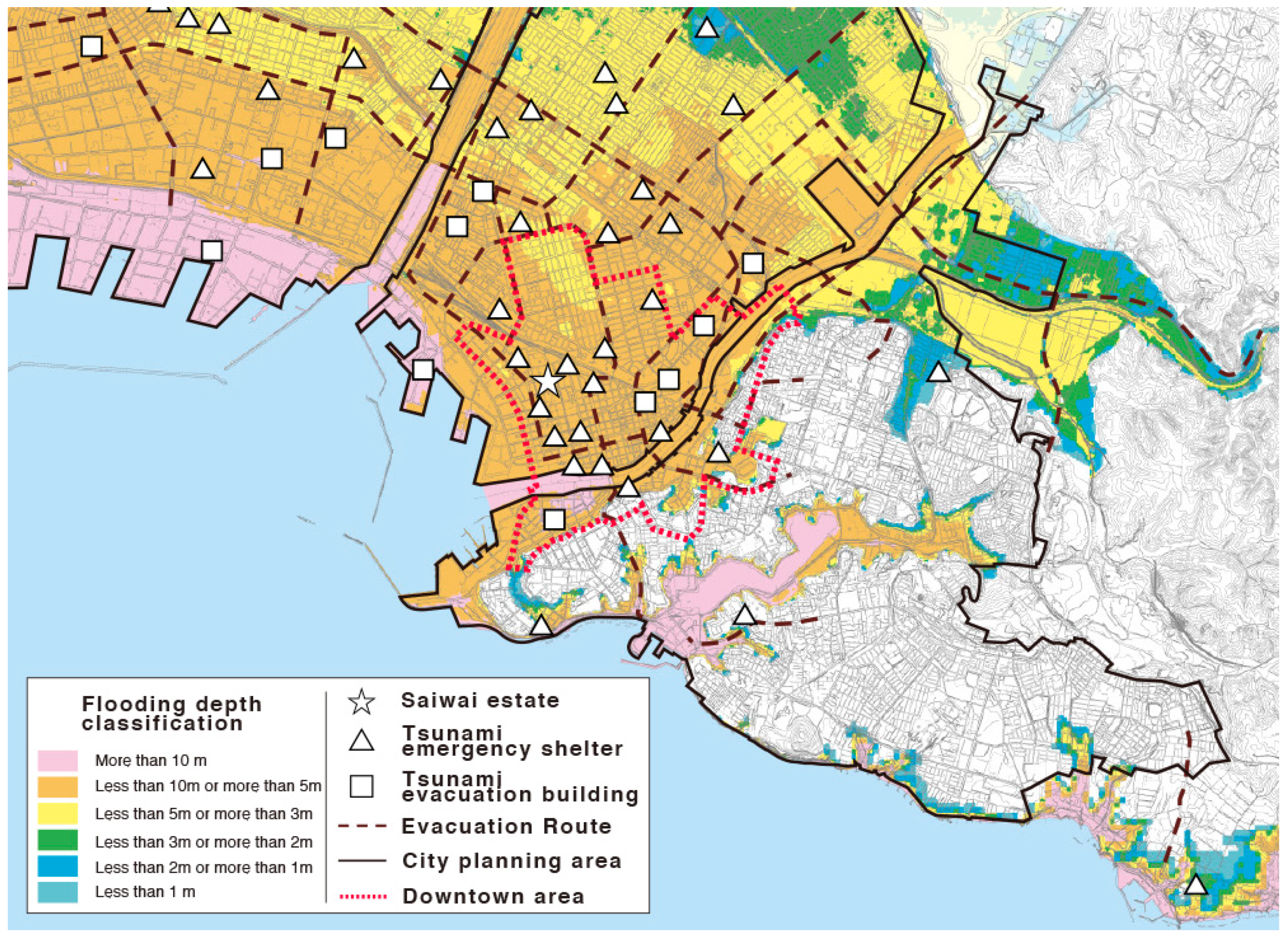
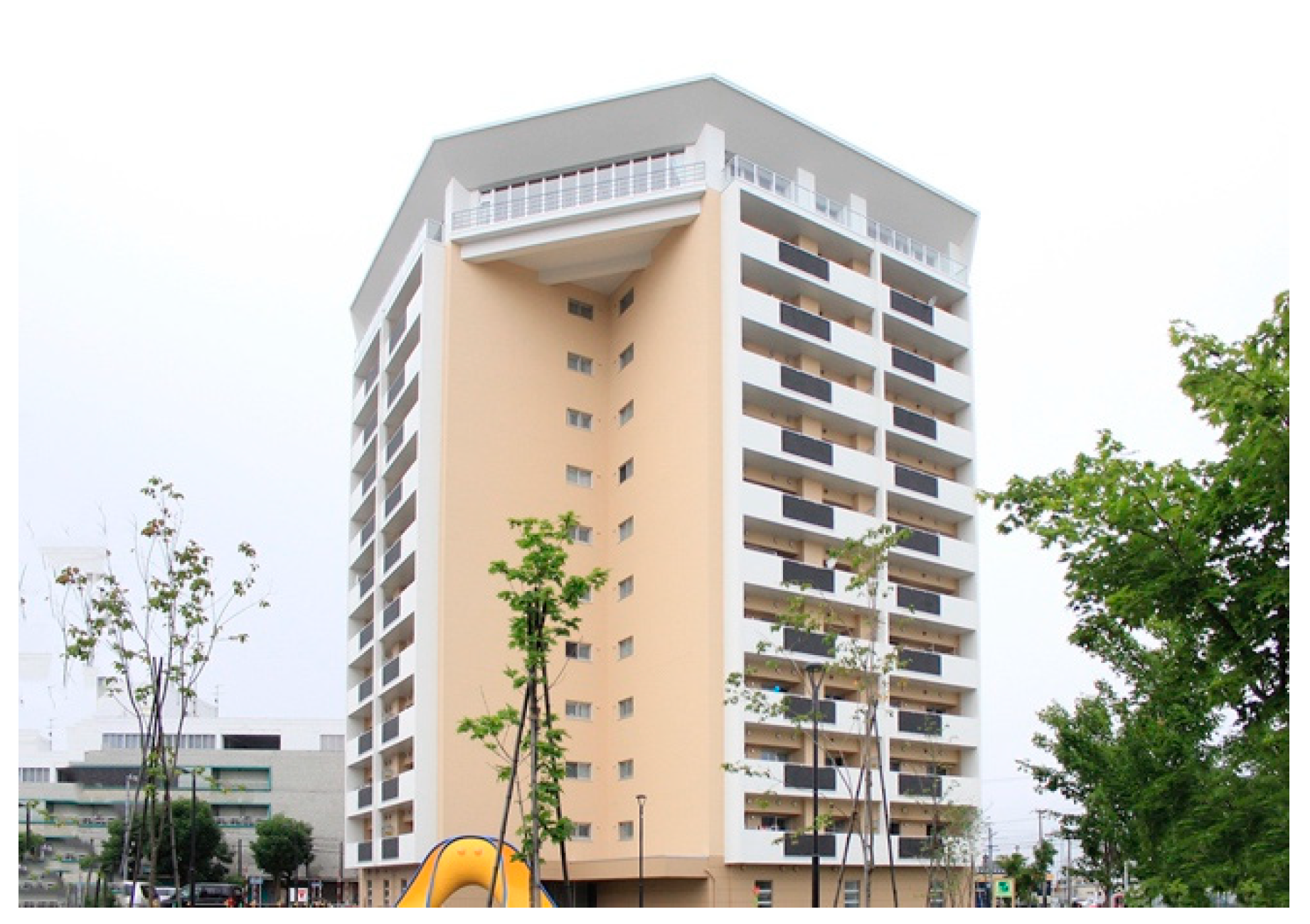


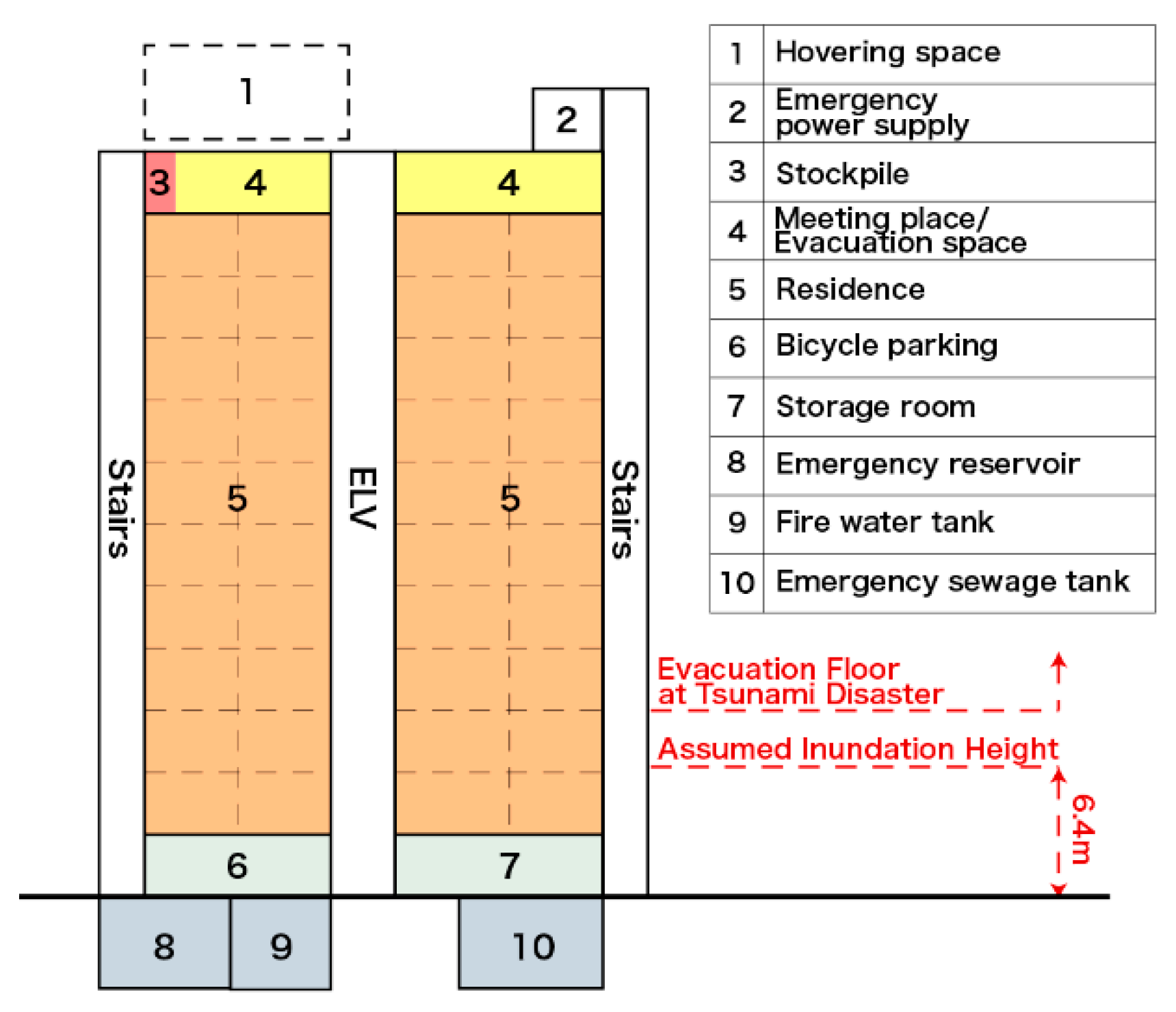

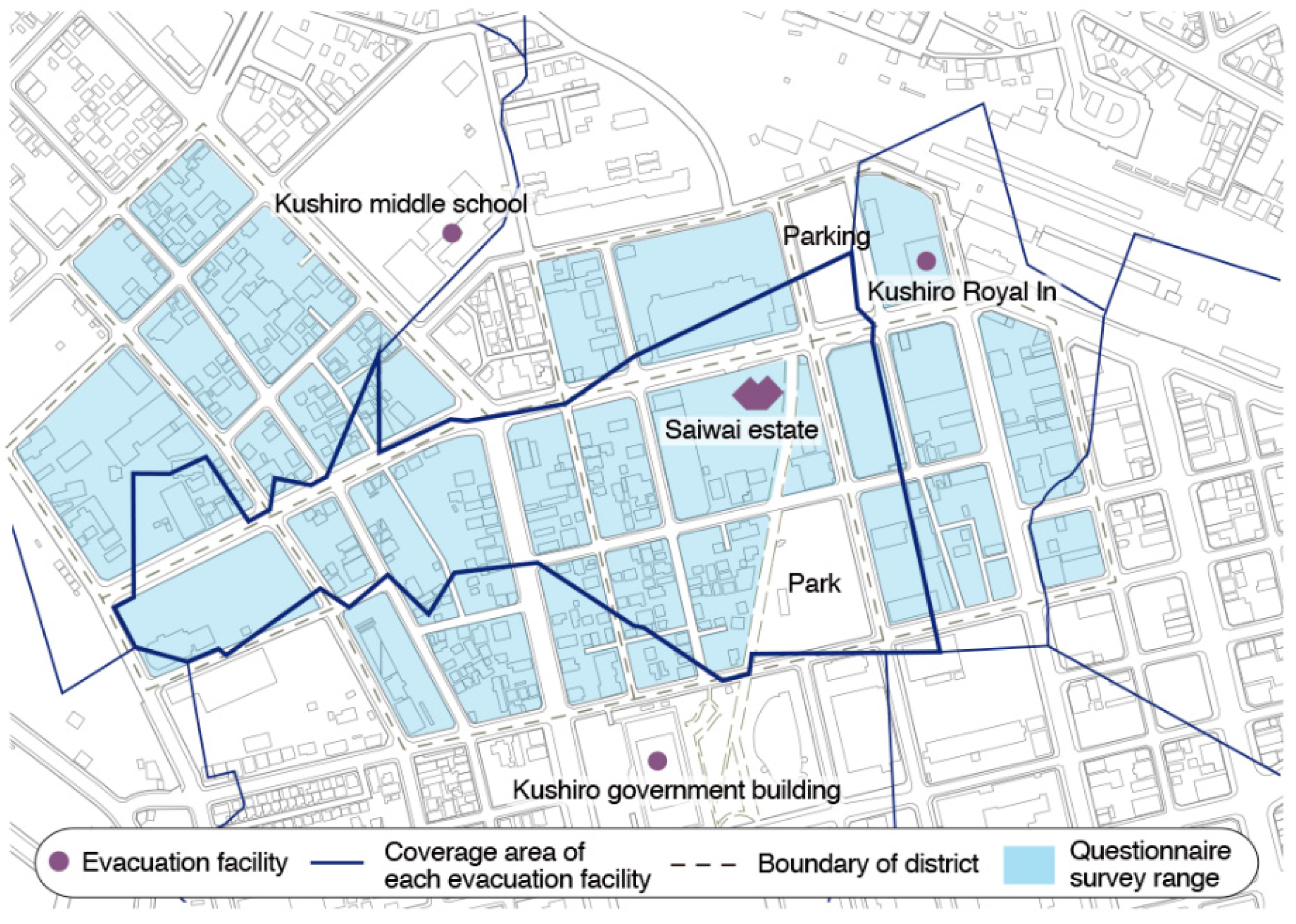

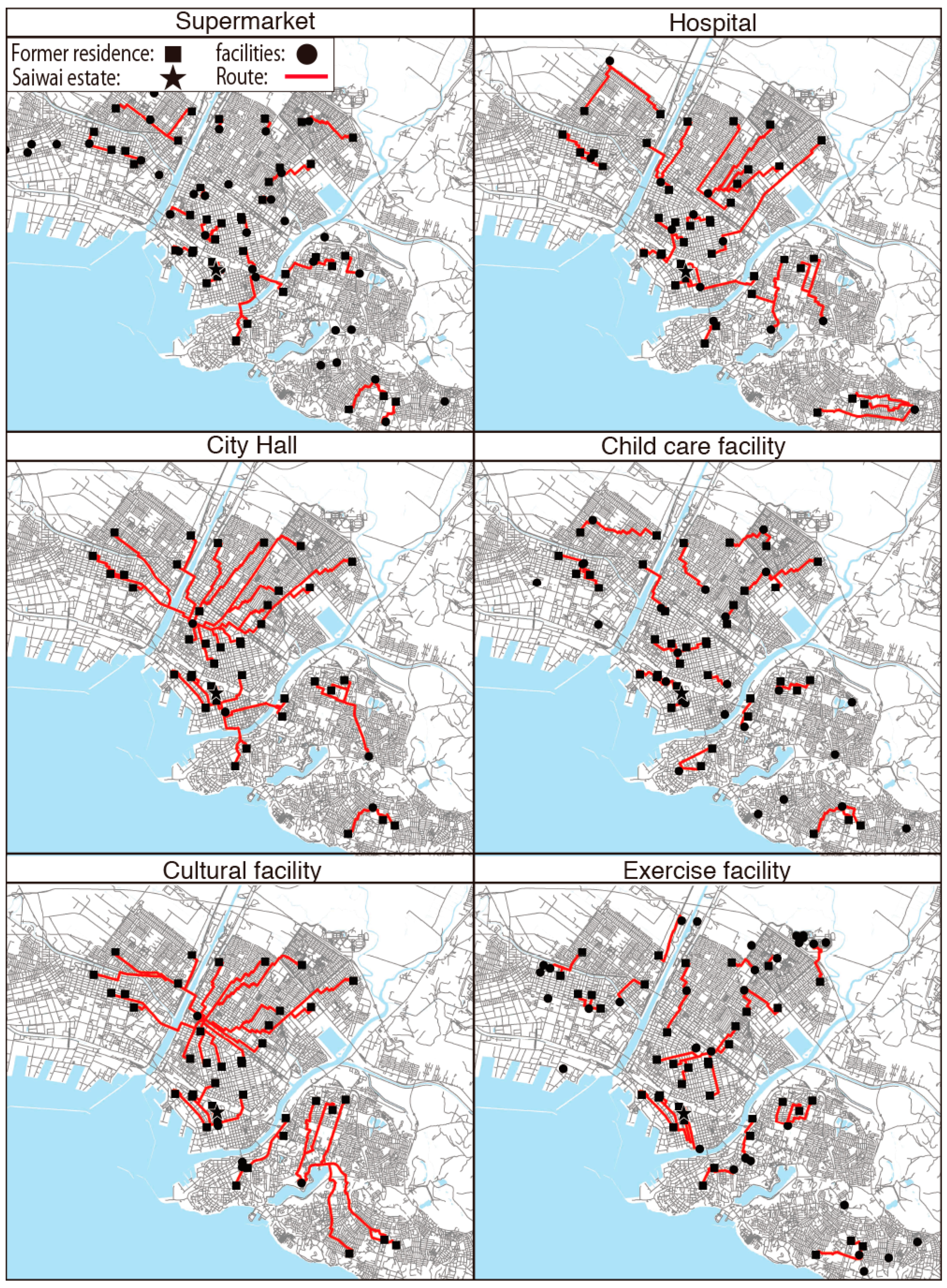

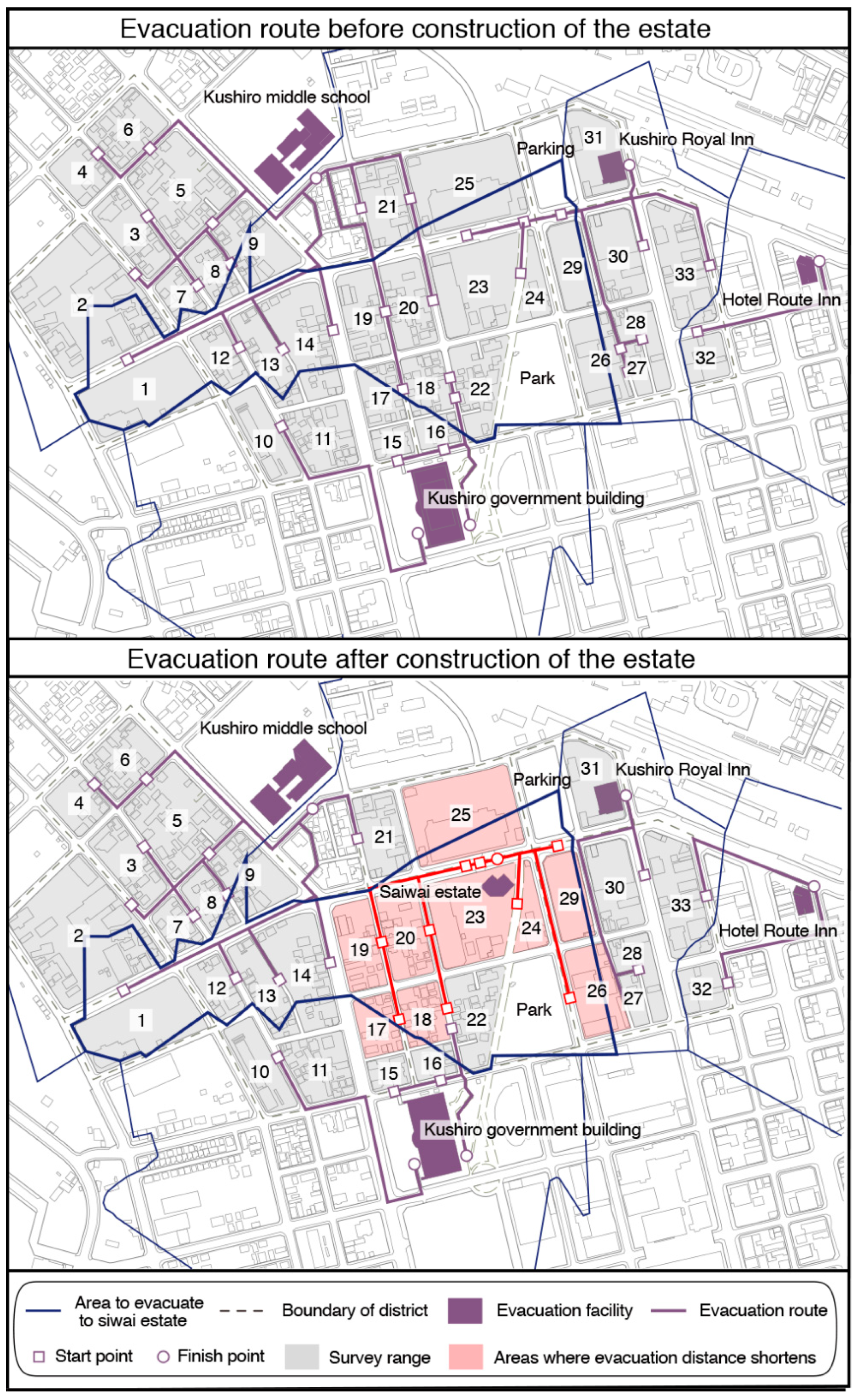
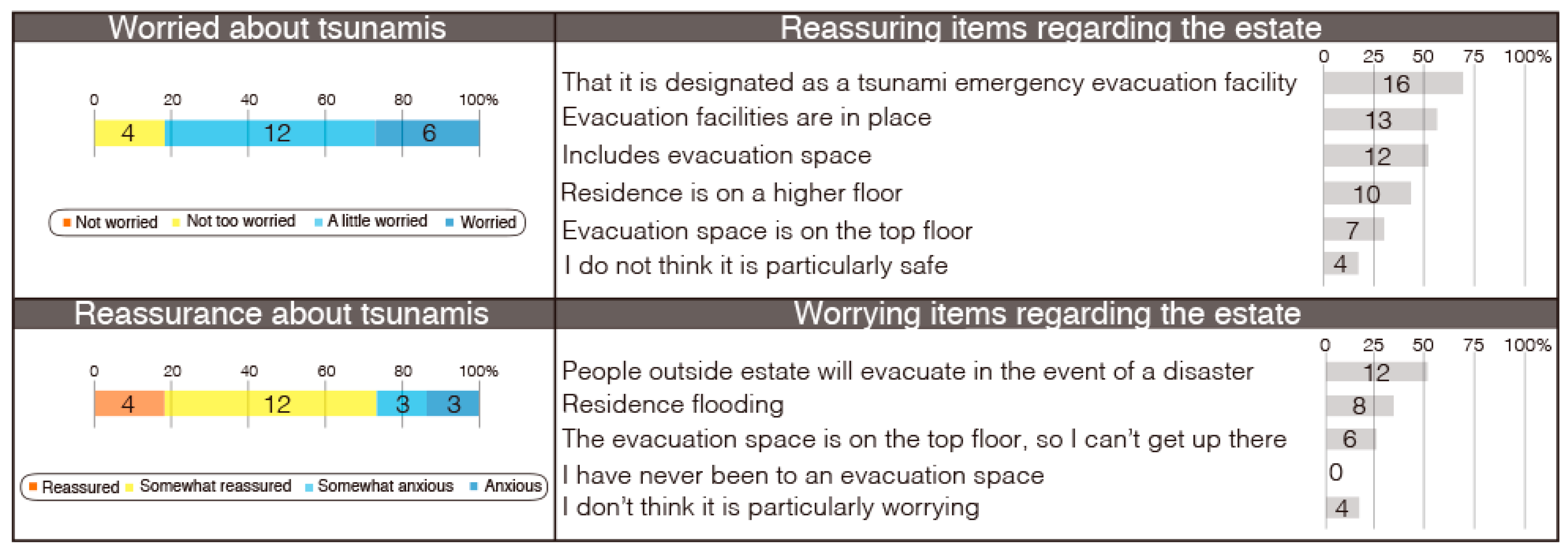

| Viewpoints of Evaluation | ||||
|---|---|---|---|---|
| Effects on the Promotion of Downtown Living | Effects on the Improvement of Tsunami Evacuation Performance | |||
| Viewpoints of Method | Placing public housing in the downtown area | Qualitative survey | [survey A-1] the effect on the everyday life convenience of residents due to living in the downtown area | [survey B] the effect on the usability of the estate as an evacuation facility due to installing a tsunami evacuation facility in the public housing |
| Quantitative survey | [survey A-2] the effect on the everyday life convenience of residents due to living in the downtown area | |||
| Installing a tsunami evacuation facility to the estate | Qualitative survey | [survey D-1 and D-2] the effect on the reassurance regarding tsunami evacuation of residents due to the construction of the estate | ||
| Quantitative survey | [survey C] the effect on the reduction of the shortest evacuation distance due to the construction of the estate | |||
| Facility | Distance of One Way | Gasoline Cost/Year | Frequency | ||
|---|---|---|---|---|---|
| Supermarket | Average | Before | 642 m | 16,854 yen | Twice/week |
| After | 164 m | 4305 yen | |||
| Changing | −478 m | −12,549 yen | |||
| Hospital | Average | Before | 1260 m | 16,539 yen | Once/week |
| After | 689 m | 9044 yen | |||
| Changing | −571 m | −7495 yen | |||
| City Hall | Average | Before | 1816 m | 11,919 yen | Twice/month |
| After | 562 m | 3688 yen | |||
| Changing | −1254 m | −8230 yen | |||
| Child-rearing facility | Average | Before | 732 m | 22,511 yen | Fifth/week |
| After | 343 m | 48,042 yen | |||
| Changing | −390 m | −25,530 yen | |||
| Cultural facility | Average | Before | 2004 m | 13,152 yen | Twice/month |
| After | 384 m | 2520 yen | |||
| Changing | −1620 m | −10,632 yen | |||
| Exercise facility | Average | Before | 1001 m | 6570 yen | Twice/month |
| After | 1058 m | 6944 yen | |||
| Changing | 57 m | 374 yen | |||
| Elementary school | Average | Before | 591 m | 38,788 yen | Fifth/week |
| After | 573 m | 37,607 yen | |||
| Changing | −20 m | −1181 yen | |||
| Middle school | Average | Before | 1045 m | 68,584 yen | Fifth/week |
| After | 1218 m | 79,939 yen | |||
| Changing | 190 m | 11,354 yen | |||
| Commuting | Average | Before | 2834 m | 186,019 yen | Fifth/week |
| After | 2466 m | 161,848 yen | |||
| Changing | −368 m | −24,171 yen |
| Block No. | Daytime Population | The Shortest Evacuation Distance | ||
|---|---|---|---|---|
| Before the Construction | After the Construction | Changing | ||
| 1 | 8 | 504 m | 504 m | 0 m |
| 2 | 101 | 430 m | 430 m | 0 m |
| 3 | 16 | 293 m | 293 m | 0 m |
| 4 | 9 | 389 m | 389 m | 0 m |
| 5 | 52 | 187 m | 187 m | 0 m |
| 6 | 31 | 360 m | 360 m | 0 m |
| 7 | 11 | 267 m | 267 m | 0 m |
| 8 | 12 | 223 m | 223 m | 0 m |
| 9 | 32 | 201 m | 201 m | 0 m |
| 10 | 110 | 372 m | 372 m | 0 m |
| 11 | 37 | 336 m | 336 m | 0 m |
| 12 | 18 | 307 m | 307 m | 0 m |
| 13 | 14 | 433 m | 433 m | 0 m |
| 14 | 27 | 407 m | 407 m | 0 m |
| 15 | 33 | 357 m | 357 m | 0 m |
| 16 | 10 | 322 m | 322 m | 0 m |
| 17 | 17 | 340 m | 316 m | 24 m |
| 18 | 20 | 328 m | 328 m | 0 m |
| 19 | 36 | 235 m | 213 m | 22 m |
| 20 | 88 | 246 m | 224 m | 22 m |
| 21 | 19 | 124 m | 124 m | 0 m |
| 22 | 34 | 314 m | 314 m | 0 m |
| 23 | 380 | 260 m | 20 m | 240 m |
| 24 | 19 | 263 m | 114 m | 149 m |
| 25 | 175 | 246 m | 18 m | 228 m |
| 26 | 83 | 292 m | 250 m | 42 m |
| 27 | 22 | 291 m | 291 m | 0 m |
| 28 | 39 | 318 m | 318 m | 0 m |
| 29 | 150 | 141 m | 87 m | 54 m |
| 30 | 370 | 182 m | 182 m | 0 m |
| 31 | 197 | 171 m | 171 m | 0 m |
| 32 | 33 | 216 m | 216 m | 0 m |
| 33 | 139 | 183 m | 183 m | 0 m |
© 2019 by the authors. Licensee MDPI, Basel, Switzerland. This article is an open access article distributed under the terms and conditions of the Creative Commons Attribution (CC BY) license (http://creativecommons.org/licenses/by/4.0/).
Share and Cite
Ito, T.; Setoguchi, T.; Miyauchi, T.; Ishii, A.; Watanabe, N. Sustainable Downtown Development for the Tsunami-Prepared Urban Revitalization of Regional Coastal Cities. Sustainability 2019, 11, 1020. https://doi.org/10.3390/su11041020
Ito T, Setoguchi T, Miyauchi T, Ishii A, Watanabe N. Sustainable Downtown Development for the Tsunami-Prepared Urban Revitalization of Regional Coastal Cities. Sustainability. 2019; 11(4):1020. https://doi.org/10.3390/su11041020
Chicago/Turabian StyleIto, Takumi, Tsuyoshi Setoguchi, Takashi Miyauchi, Akira Ishii, and Norihiro Watanabe. 2019. "Sustainable Downtown Development for the Tsunami-Prepared Urban Revitalization of Regional Coastal Cities" Sustainability 11, no. 4: 1020. https://doi.org/10.3390/su11041020
APA StyleIto, T., Setoguchi, T., Miyauchi, T., Ishii, A., & Watanabe, N. (2019). Sustainable Downtown Development for the Tsunami-Prepared Urban Revitalization of Regional Coastal Cities. Sustainability, 11(4), 1020. https://doi.org/10.3390/su11041020




